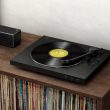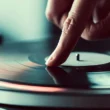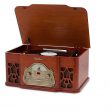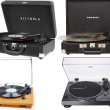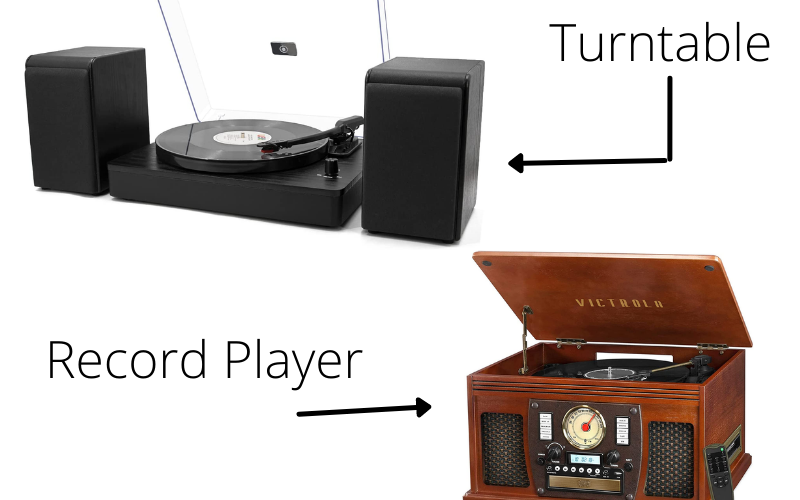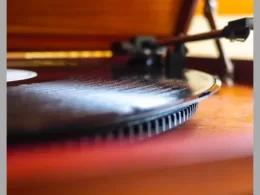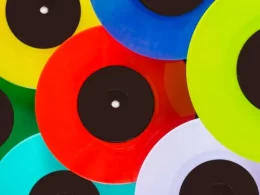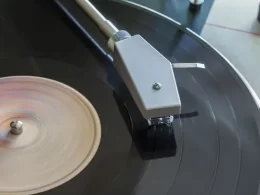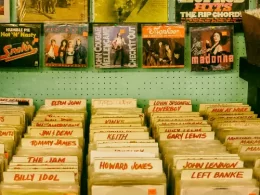So we keep hearing these words record player and turntable, and while most people use these words as synonyms and in context interchangeably, there are differences between the pair. To better understand these words and the tandem between them, let us delve into a brief history of the two.
The phonograph was first invented in 1877, and after years of electrical and technological advancements, it quickly started being referred to as the record player by the public. For almost a hundred years, record players acted as the main staple for people to enjoy their music daily — so this scenario begs the question: what is a turntable, and why is a different term even needed if record player preceded it and was used commonly?
Let’s move towards the clear difference between a record player and a turntable to answer all your questions.
What is Turntable?
The turntable is a device that contains a platter that spins the record and is equipped with the tonearm or cartridge that works to pick up the music from the record. If you purchase only a turntable, then you’d need to buy an amplifier, speakers, preamp to play the vinyl. This shows that the turntable isn’t all in one vinyl playing unit.
What is Record Player:
A record player is all in one device as compared to a turntable,. You’ll not need to purchase any extra components to play the vinyl by that we mean.
When you purchase a record player, it’ll have a preamp, amplifier, turntable, speakers all in one unit. Mainly the record player is portable but is heavy.
Anatomy Of A Turntable
1. Stylus:
What those unfamiliar with the specific terms would call “a needle,” the stylus is the part of the best turntable for money that comes into contact with the record. This part generates the vibrations by running through the grooves of the record that then travel through the tonearm (more on that later) to become sound eventually. Made from diamond or sapphire, styli can be either spherical or elliptical.
2. Plinth:
Simply put, this is the base framework and housing of the machine. Make sure it looks fantastic.
3. Tone Arm:
Pretty easy to understand the origin of its name, this component looks like an actual arm and is dedicated to holding the cartridge and stylus at one end, and combined with the counterweight and various other mechanisms at the other end, is responsible for transporting vibrations that ultimately get emitted as sound.
Tonearms come either as straight or curved. And although many say that curved arms produce better sounds, most DJs prefer the straight arm as it is easier to scratch.
If the tonearm is off-canter from its desired position, the cartridge and stylus will not be parallel with the record and thus significantly affect sound clarity. Most affordable turntables will come with straight arms, and the higher-priced ones will most likely be curved.
4. Platter:
A visual staple among all turntables and record players, the platter is the circular portion on the surface of the plinth that acts as a plate for the record to sit on. However, there are various design features throughout the spectrum of turntables.
One feature widely accepted as a positive one is a heavy platter with suitable bearings — proper weight-bearing method assures for low friction and a turntable that has its rotating mass spin at a constant rate and is less prone to suffer from excess noise and any disturbances or variations in speed.
5. Mat:
A soft, rubbery material that sits on top of the platter and is meant to grip and act as a soft cushion for the record to sit on. The mat also acts to minimize vibrations from the internal motor.
6. Counterweight:
Responsible for something called “tracking force,” this component acts as the tool to adjust the amount of downward pressure the stylus exerts on a record — too little tracking force, and the track will constantly skip, too much force and you will cause damage to the stylus and the record.
7. Cartridge:
Attached to the end of the tonearm opposite the stylus, the turntable cartridge is the final destination of vibrations. Once the cartridge arrives, the vibrations get transformed into electrical signals via coils inside the cartridge itself.
8. Anti-Skate:
Naturally, the tonearm and stylus will want to pull towards the center of the record, leading to damage of the record grooves. But good thing for a little something called Anti-Skate! This allows you to adjust how much horizontal force is being applied to the tonearm.
9. Preamp (Phonostage):
Commonly referred to as a ‘Phono Preamp’ to somebody who is just learning about turntables or audio equipment in general, the concept of a preamp might be a little confusing. No worries, we’re here to help. Inherently turntables produce PHONO output signals.
These output signals need to be converted to LINE LEVEL signals, commonly referred to as an AUX signal, to work with electrical audio systems such as headphones or speakers.
And this is what a preamp does: it converts phono signals to line-level signals. Some turntables have preamps built-in, while others do not. Preamps vary greatly in cost and quality.
Anatomy Of Record Player
In a record player, all the necessary components are embedded in one unit. A record player contains:
1. Turntable
2. Preamp
3. Amplifier
4. Speakers
Everything already is in the record player, so you’ll not need to purchase any extra equipment, boxes, or cables. Each component of the record player comes fixed from the factory, so chances of upgrading or changing are rare.
Which one to purchase? A turntable or record player?
Honestly, we won’t use the term better, which is subjective because everyone has their criteria for choosing a product. But these days, most people in every situation prefer using turntables. Why? Let me give you three main reasons to prefer turntable over record player:
Quality & Buildup
Usually, the turntable has strong construction and is based on good quality compared to the record player. Turntables are created to lasts longer than the record player.
Compared with turntables, the record player is mainly built to be lightweight, portable, cool, and readily available at a low price. Even if we build a record player at a high price, it still can’t beat the turntable build quality.
Sound Quality
There’s no use of a sound system if it doesn’t deliver good music to your ears. Record player mostly has a lower-end spectrum due to the mini built-in speakers. The record player has a tiny amplifier that can’t produce a good bass in the music. That’s why people left record players and switched to the turntables.
Due to the low price of most record players available in the market, the quality of the components will be poor results in low sound quality. No one is willing to pay a high price for the record players in today’s market. This is why the manufacturers have to make it at low rates. Compared to the record player, the turntable has a great sound quality.
Even if you purchase an affordable turntable, the sound quality will be far better than the record player. And with the turntable, you have an option to connect it with any premium quality component of your choice to boost the sound production. In this way, you’ll be able to create a high-end stereo sound system at home.
Vinyl Wear & Tear
The record player has a high tracking force that could ruin the records as 2grams downforce, or 6gram downforce is way too high for the vinyl. This is why one should keep the record collection away from the player to protect it.
Moreover, record wear and tear are quite high due to the poor cartridge alignment. However, in turntable, you can easily adjust the force, and adjustments according to your vinyl result in lesser chances of wear and tear.
Why purchase a turntable?
So what if you’re a person who is reading all of this and you still find yourself asking things like “Why should I even buy a turntable?” and “What’s the point? My phone works as a perfect music player” or even something like “Isn’t the concept of having a turntable old and outdated?” which would be all reasonable notions to have.
I mean, surely there are plenty of people out there who aren’t purchasing their second, third, or fourth turntable. So if you are one of those people looking to buy your first turntable, the question must arise: why even buy one in the first place? Let’s go through some reasons.
1. Better Sound Quality:
Before we go further, we are not saying that vinyl sounds definitively better than any CD or audio file because the sound is subjective. What may sound good to one person can’t possibly be assumed to sound good to another.
But what we are saying is that the use of the top record players and vinyl allows the user more customization and precision in achieving specific sounds and tones. And although not ironclad, many audiophiles believe that sound reproduction from analog (vinyl) has much warmer and richer tones than that of any digital sound reproductions.
Having the ability to change and upgrade specific components of your turntable means you can adjust the factors that contribute to the sound quality of your turntable, components such as the tonearm, cartridge, platter, etc.
And on top of that, these parts can often be further adjusted to achieve even more precision in sound quality and reproduction. But if you haven’t listened to some of your favorite albums on vinyl yet, we suggest giving those albums a listen or two on CD or MP3 and then listening to those same albums again on vinyl.
With a properly setup, the best turntable for listening, and an audio system, it should feel as if you’re listening to that album for the first time in a different way. And what we mean by that is that many things must be considered when talking about sound reproduction.
2. The Experience:
Nowadays, it’s all random playlists this, and shuffle artists that — people put their headphones on, plug their auxiliary cables in, click a button, and voila! MUSIC! It’s almost as if music most of the time is an afterthought in our everyday lives.
And although I would be a hypocrite if I said I never got lazy or content when it came to my impulsive need for my music library, please allow me to divulge a somewhat different experience of listening to music.
Sifting through your records, each one does not represent pixels but an actuation of physical matter gracing through your passing fingertips.
The connection to the music and your want for it are more personal. You finally find the album you’re seeking; not touch on a screen or the click of a button, but like the plucking of a flower or the removal of an ordinary book from a shelf — yeah, there it is. That’s the one.
You hold the paper sleeve in your hands, gazing at what seems like a piece of art in and of itself, and proceed to remove your prize. You inspect the surface for any accumulated dust and clean it off if necessary.
Your turntable is ready, you place the vinyl down, set the stylus in the groove, and that familiar soft thud welcomes you, and once again, you’re gently reminded as to the true immersion of the music you love.
3. Building a Collection
Imagine trying to explain to someone how much pride you have in your CD collection or your iTunes library in contrast to an illustrious shelf of artistic envelopes filled with different colored types of vinyl. I think it’s pretty clear to see which one entails a sense of ownership and pride.
On top of having blatantly different physical characteristics from its other musical reproduction counterparts, vinyl often accrues value. In contrast, certain ones come out as special editions or just become hard to find as more years pass by.
A collection of vinyl should be organized!
Compare that to CDs, which hold very little value, if any, or your digitally purchased music libraries, which you certainly can’t sell back to Apple, Sony, Spotify, or Google. Many artists use vinyl to add a particular element of exclusivity, importance, and value to what they are releasing.
If you’re curious, search for the artist Portugal. The Man’s single “Sumatran Tiger” and artist Wu Tan Clan’s record “Once Upon a Time in Shao-lin,” are exciting. Some vinyl is and can become very collectible and rare, even if they aren’t purposely made to be that way, to begin with.
What You Need for A Turntable
It’s true that just buying a good record player is not all you need to get those records spinning. You’re going to need a few things first. If your turntable comes with a preamp, as most new products do, you will only need an amp or receiver to plug it into, which would then go directly into your speakers. If your turntable does not have a built-in phono preamp, you need to get one separately.
Aside from that, we also recommend buying a new cartridge with your turntable. Chances are, the one that it comes with is not up to par in terms of quality, so that should be replaced with a better product as that would vastly improve the sound that your turntable produces.
So, to organize everything, this is what you’ll need for a turntable:
1. Phono Pre-amp:
Either built into the turntable, receiver or purchased separately. If your preamp does not have a phono stage, you will need a phono amp to plug into the preamp. Cheap ones do just fine.
2. Power amp or Receiver:
This is a crucial part of your build and will determine how the sound comes out of your speakers. It makes sense to spend more here.
3. Speakers:
The final part of the chain and where the sound ultimately comes out of. Like the power amp or receiver, the better the speakers, the better the sound quality you will receive from your rig.
Other optional items include a record brush to clean your records and a record shelf to store your records adequately.

